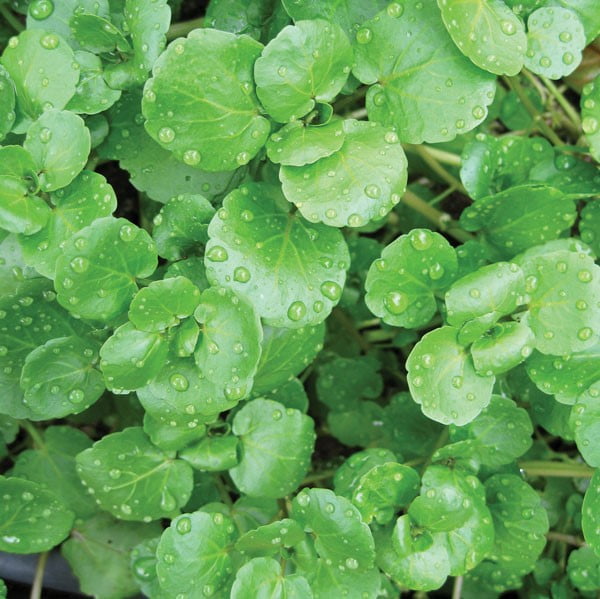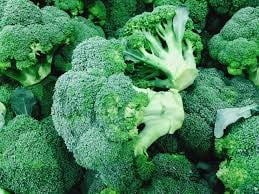Isothiocyanates are biologically active hydrolysis (breakdown) products of glucosinolates. Cruciferous vegetables contain a variety of glucosinolates, each of which forms a different isothiocyanate when hydrolyzed. For example, broccoli is a good source of glucoraphanin, the glucosinolate precursor of sulforaphane (SFN), and sinigrin, the glucosinolate precursor of allyl isothiocyanate (AITC) (2). Watercress is a rich source of gluconasturtiin, the precursor of phenethyl isothiocyanate (PEITC), while garden cress is rich in glucotropaeolin, the precursor of benzyl isothiocyanate (BITC). At present, scientists are interested in the cancer-preventive activities of vegetables that are rich in glucosinolates as well as individual isothiocyanates (3). The health benefits of watercress is attributed to its nutrient content. Watercress is an excellent source of vitamins B1, B2, B6, C, E, manganese, and carotenes. It’s also a good source of calcium, fiber, iron and copper.
Benefits of Watercress
The study in which watercress appeared to halt tumor growth was led by Professor Graham Packham, a molecular oncologist at the University of Southampton. Packham worked with Barbara Parry, a Senior Research Dietician at the Winchester and Andover Breast Unit. Parry and Packham asked a small group of breast cancer survivors to fast for a period of time, and then to eat 80g of watercress (about enough to fill a cereal bowl). The team took a series of blood samples over the next 24 hours. Following the watercress meal, the blood samples contained significant levels of a specific cancer-fighter contained in watercress. More importantly, researchers confirmed that the functions needed for angiogenesis were halted.
As excited as he is about the study’s results, Professor Packham is disappointed that more people aren’t investigating how diet influences illness, especially cancer. “Knowing the risk factors for cancer is a key goal and studies on diet are an important part of this. However, relatively little work is being performed…on the links between the foods we eat and cancer development.”
Myrosinase-catalyzed Glucosinolate Hydrolysis and Chemical Structures of Selected Isothiocyanates
Phenethyl Isothiocyanate (PEITC): A natural metabolite of glucosinolates from watercress, has been found, for example, to down-regulate androgen receptors, minimizing stimulation of prostate cancer by testosterone.15
Watercress Extract
Watercress is especially rich in another glucosinolate derivative, called phenethyl-isothiocyanate (PEITC).4 PEITC inhibits carcinogen-activating enzymes, induces cancer detoxification enzymes, and protects against DNA damage.4,5 PEITC is also a remarkably specific epigenetic modulator that turns on genes that suppress cancer.6,7 These effects make watercress extracts particularly appealing in the case of some of our most potent environmental carcinogens, such as those found in tobacco smoke.8-10 Watercress and PEITC are showing promise in other malignancies caused by activated carcinogens, such as colorectal and prostate cancers.11-13
Watercress extract with PEITC also contain small amounts of other detoxifying enzyme inducers with even greater potency.4 These substances help prevent cancer growth by reducing inflammatory stimuli such as nitric oxide.14
Nutrition Facts
Watercress herb powder
Nutrition Facts 100 grams
Amount Per Serving
Calories 11
Total Fat 0.1g
Saturated Fat 0g
Trans Fat 0g
Cholesterol 0mg
Sodium 41mg
Potassium 330mg
Total Carbohydrate 1.29g
Dietary Fiber 0.5g
Sugars 0g Added 0 sugar
Protein 2.3g
Vitamin A 3191 IU
Vitamin D 0 mcg
Calcium 120 mg
Iron 0.2 mg
Vitamin C 43 mg
*Percent Daily Values are based on a 2000 calorie diet. Your daily values may be higher or lower depending on your calorie needs.
Ingredients: watercress herb powder
References
Fahey JW, Zalcmann AT, Talalay P. The chemical diversity and distribution of glucosinolates and isothiocyanates among plants. Phytochemistry. 2001;56(1):5-5
Zhang Y. Cancer-preventive isothiocyanates: measurement of human exposure and mechanism of action. Mutat Res. 2004;555(1-2):173-190.
Hecht SS. Chemoprevention by Isothiocyanates. In: Kelloff GJ, Hawk ET, Sigman CC, eds. Promising Cancer Chemopreventive Agents, Volume 1: Cancer Chemopreventive Agents. Totowa, NJ: Humana Press; 2004:21-35.
Rose P, Faulkner K, Williamson G, Mithen R. 7-Methylsulfinylheptyl and 8-methylsulfinyloctyl isothiocyanates from watercress are potent inducers of phase II enzymes. Carcinogenesis. 2000 Nov;21(11):1983-8.
Gill CI, Haldar S, Boyd LA, et al. Watercress supplementation in diet reduces lymphocyte DNA damage and alters blood antioxidant status in healthy adults. Am J Clin Nutr. 2007 Feb;85(2):504-10.
Wang LG, Liu XM, Fang Y, et al. De-repression of the p21 promoter in prostate cancer cells by an isothiocyanate via inhibition of HDACs and c-Myc. Int J Oncol. 2008 Aug;33(2):375-80.
Hofmann T, Kuhnert A, Schubert A, et al. Modulation of detoxification enzymes by watercress: in vitro and in vivo investigations in human peripheral blood cells. Eur J Nutr. 2009 Dec;48(8):483-91.
Hecht SS, Chung FL, Richie JP, Jr., et al. Effects of watercress consumption on metabolism of a tobacco-specific lung carcinogen in smokers. Cancer Epidemiol Biomarkers Prev. 1995 Dec;4(8):877-84.
Hecht SS. Approaches to chemoprevention of lung cancer based on carcinogens in tobacco smoke. Environ Health Perspect. 1997 Jun;105 Suppl 4:955-63.
Chung FL, Morse MA, Eklind KI, Xu Y. Inhibition of tobacco-specific nitrosamine-induced lung tumorigenesis by compounds derived from cruciferous vegetables and green tea. Ann N Y Acad Sci. 1993 May 28;686:186-201; discussion 01-2.
Chung FL, Conaway CC, Rao CV, Reddy BS. Chemoprevention of colonic aberrant crypt foci in Fischer rats by sulforaphane and phenethyl isothiocyanate. Carcinogenesis. 2000 Dec;21(12):2287-91.
Chiao JW, Wu H, Ramaswamy G, et al. Ingestion of an isothiocyanate metabolite from cruciferous vegetables inhibits growth of human prostate cancer cell xenografts by apoptosis and cell cycle arrest. Carcinogenesis. 2004 Aug;25(8):1403-8.
Khor TO, Cheung WK, Prawan A, Reddy BS, Kong AN. Chemoprevention of familial adenomatous polyposis in Apc(Min/+) mice by phenethyl isothiocyanate (PEITC). Mol Carcinog. 2008 May;47(5):321-5.
Rose P, Won YK, Ong CN, Whiteman M. Beta-phenylethyl and 8-methylsulphinyloctyl isothiocyanates, constituents of watercress, suppress LPS induced production of nitric oxide and prostaglandin E2 in RAW 264.7 macrophages. Nitric Oxide. 2005 Jun;12(4):237-43.
Beklemisheva AA, Feng J, Yeh YA, Wang LG, Chiao JW. Modulating testosterone stimulated prostate growth by phenethyl isothiocyanate via Sp1 and androgen receptor down-regulation. Prostate. 2007 Jun 1;67(8):863-70.











Reviews (0)
There are no reviews yet.